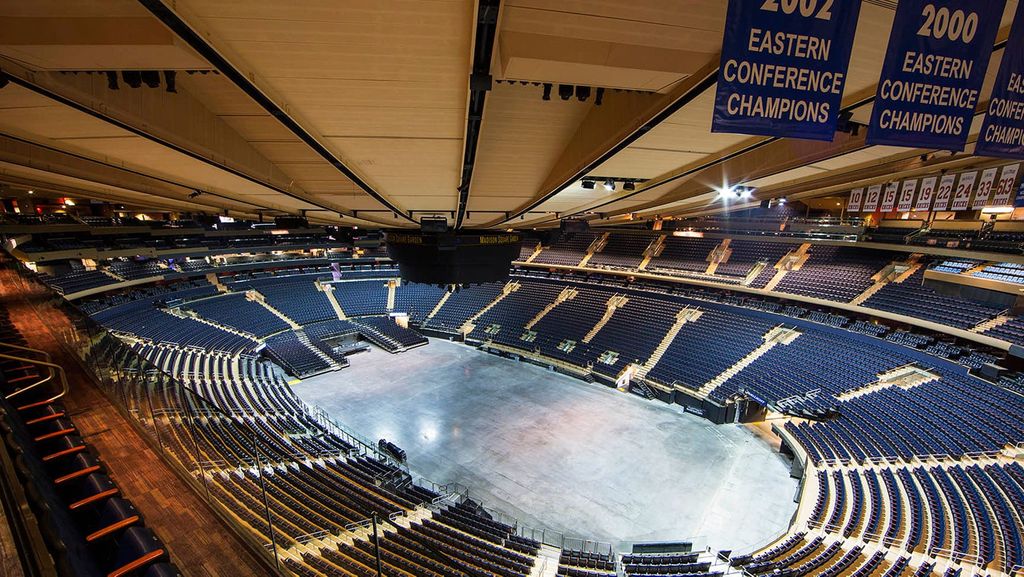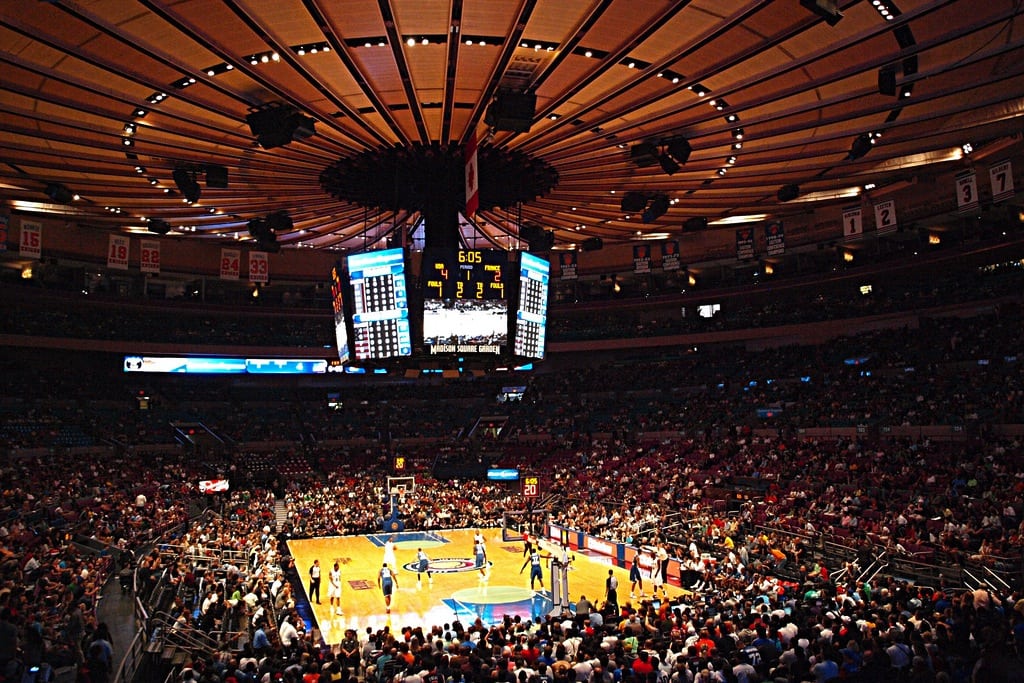MSG Capacity: What You Need To Know About Madison Square Garden
Ever wondered just how many souls can pack into the legendary Madison Square Garden? The answer isn't as straightforward as you might think; it's a dynamic figure that shifts depending on the spectacle unfolding within its walls.
Madison Square Garden, affectionately known as MSG, stands as an iconic landmark in the heart of New York City. Nestled in midtown Manhattan, between Seventh and Eighth Avenues, from 31st to 33rd Streets, and perched above Pennsylvania Station, MSG has been a stage for countless historic moments. From electrifying concerts and nail-biting sporting events to captivating performances, the Garden's versatility is a key element of its enduring appeal. But precisely how many people can it hold?
| Venue Name | Madison Square Garden (MSG) |
| Location | Midtown Manhattan, New York City (between Seventh and Eighth Avenues, from 31st to 33rd Streets) |
| Address | 4 Pennsylvania Plaza, New York, NY 10001 |
| Seating Capacity (Basketball) | Approximately 19,000 |
| Seating Capacity (Hockey) | Approximately 18,000 |
| Seating Capacity (Concerts) | Upwards of 20,000 (depending on stage configuration) |
| Maximum Capacity (as per MSG website) | 19,500 (prior to production kills) |
| Maximum Legal Capacity (as per legal filings) | 21,000 |
| Original MSG (1879) Capacity | 10,000 |
| Website | www.msg.com |
The reality is, there's no single definitive answer. Madison Square Garden's capacity is a chameleon, adapting to the specific needs of each event. A basketball game will have a different configuration than a hockey match, and a concert will demand a completely different setup altogether. Let's break down the numbers for a clearer picture.
- Find Tienda Hondurea Near You Info Tips Google Search
- Dario Sepulveda The Untold Story Griseldas Husband Explained
For basketball aficionados, MSG typically accommodates around 19,000 fans, creating an electric atmosphere for New York Knicks games. Hockey enthusiasts can expect a slightly smaller crowd, with seating for approximately 18,000 spectators during New York Rangers games. The difference stems from the staging and logistical requirements of each sport.
Concerts, however, often see the Garden's capacity swell. With the basketball court or hockey rink removed, additional space becomes available, allowing for floor seating and a larger overall audience. For a major concert, the stadium can hold just over 20,000 people. The actual number fluctuates based on the stage design and the artist's specific requirements. Some setups maximize seating, while others prioritize the stage presence and visual experience, impacting the final capacity.
Even Madison Square Garden's official website provides varying figures. It indicates a maximum capacity of 19,500 people "prior to production kills." This refers to the number of seats that are removed or blocked off to accommodate stage equipment, lighting rigs, and other production elements necessary for a large-scale event. These "production kills" directly affect the number of tickets available for sale.
- Enhypens Rise Records Rms Advice Golden Disc Awards Get The Latest
- Dive Into Custom Udon Aki H Your Perfect Noodle Experience
Adding to the complexity, legal filings by the company that owns MSG have cited a maximum capacity of 21,000. This figure likely represents the absolute maximum number of people that could theoretically be crammed into the venue, adhering to fire safety regulations and other occupancy codes. However, this number is rarely, if ever, reached in practice, as it would likely compromise the comfort and safety of attendees.
The story of Madison Square Garden is one of constant evolution. For over 125 years, New York City has been home to four different incarnations of this legendary venue. The first, located at Madison Avenue and 26th Street, opened in 1879 and primarily hosted track cycling events until 1890. With a seating capacity of 10,000, it was also famously used by P.T. Barnum for his circuses, who dubbed it the "Great Roman Hippodrome."
The second Madison Square Garden was built on the same site in 1890. It was a grander structure, hosting a wider range of events, but was eventually demolished in 1925 to make way for new developments. The current Madison Square Garden, the fourth in the lineage, continues to uphold the tradition of hosting world-class events.
The versatility of Madison Square Garden was put to the test recently with a rally held by former President Donald Trump on October 27, 2024. While the event generated significant buzz and drew a large crowd, reports emerged of many Trump supporters being turned away, sparking outrage among some attendees. Doors were scheduled to open at 12 p.m., with the program expected to start around 5 p.m., leading to a long wait for those hoping to gain entry.
Estimates suggest that roughly 10,000 people had assembled by early Sunday, eager to witness the rally. However, as the afternoon progressed, the NYPD began turning people away, citing capacity limitations. One New York City police officer told the New York Post that thousands were denied entry. The exact reasons for the turn-aways remain a subject of debate, with some speculating about security concerns or logistical challenges.
It's crucial to note that no credible news outlet has reported that 200,000 people attended the rally. Such a figure would be wildly inconsistent with the venue's known capacity. Several news outlets reported that Madison Square Gardens capacity for the event was less than 20,000 people, which aligns with the Garden's typical concert configuration.
Vice President Kamala Harris also held an event in Houston, Texas, on October 25, 2024, demonstrating the intense political activity leading up to the election. While the focus here is on the events at Madison Square Garden, it's important to recognize the broader context of political rallies and public gatherings across the country.
The events surrounding the Trump rally at Madison Square Garden highlight the complexities of managing large crowds and adhering to safety regulations. While the enthusiasm of supporters was undeniable, the venue's capacity limitations ultimately dictated how many people could be accommodated. The disappointment experienced by those who were turned away underscores the importance of careful planning and clear communication when organizing large-scale events.
So, to definitively answer the question of how many people can fit in Madison Square Garden, it's a nuanced answer. For basketball, think around 19,000. For hockey, approximately 18,000. And for concerts, expect something over 20,000, depending on the specific setup. The Garden's versatility is its strength, allowing it to adapt to a wide array of events while consistently providing a memorable experience for attendees. From its humble beginnings in 1879 to its current iconic status, Madison Square Garden continues to be a vital part of New York City's cultural landscape, a place where history is made and legends are born.
Understanding the capacity of Madison Square Garden requires looking beyond a single number. It involves considering the type of event, the stage configuration, and the various logistical factors that influence seating arrangements. Ultimately, the Garden's enduring appeal lies not just in its size, but in its ability to create a unique and unforgettable experience for every audience, regardless of the event.
The recent rally, with its reported turn-aways, serves as a reminder of the challenges involved in managing large crowds and ensuring the safety and comfort of attendees. While the desire to accommodate everyone is understandable, the venue's capacity limitations must be respected to prevent overcrowding and potential hazards.
In conclusion, the question of how many people can fit in Madison Square Garden is best answered with a range, acknowledging the dynamic nature of the venue and its ability to adapt to different types of events. Whether it's a basketball game, a hockey match, a concert, or a political rally, Madison Square Garden remains a premier destination for entertainment and a symbol of New York City's vibrant culture.
Consider the history. The original Madison Square Garden opened in 1879. P.T. Barnum called it the Great Roman Hippodrome. The second garden was demolished in 1925. Each iteration reflects changing times and entertainment preferences.
It's not just about the numbers. It's about the atmosphere, the energy, and the shared experience. Madison Square Garden is more than just a venue; it's a place where memories are made.
The incident on October 27, 2024 serves as a case study. Thousands were reportedly turned away from a Trump rally. This highlights the importance of realistic expectations and crowd management.
- Prison Break Michael Scofields Wife The Story Unfolds
- Ella Dixon Parents What You Need To Know Latest

How Many People Can Fit in Madison Square Garden Hompros

Madison Square Garden Turismo Nueva York

How Many People Does Msg Hold Can Fit In Madison Square Garden Hompros